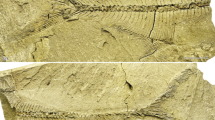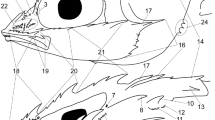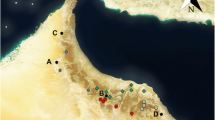Abstract
The monophyly of Polynemidae was evaluated and its sister relationship with Sciaenidae discussed, based on osteological and myological characters from 24 polynemid species in eight genera, with comparisons with acanthomorph fishes from literature and 86 species in 8 orders and 63 families examined. Polynemidae was inferred as a monophyletic group, strongly supported by 19 synapomorphies, including four unique characters (unnamed bone present on cephalic sensory canal extending from supratemporal, third actinost not supporting pectoral-fin rays, section A1 comprising lateral and medial elements, and division of obliquus inferioris present between lower postcleithrum and rod-like process on coracoid) in percoids. In addition, seven pectoral girdle characters were recognized, with the girdle possessing filament-like sensory rays, an adaptation to benthic life in muddy water. The sister relationship of Polynemidae and Sciaenidae was supported by six synapomorphies, including two rather rare (a single branchiostegal ray suspended by epihyal and posterior portions of pelvic bones on both sides interdigitated) and two unique characters (metapterygoid and quadrate interdigitated medially and anterior extension of the nasal canal).












Similar content being viewed by others
References
Betancur-R R, Broughton RE, Wiley EO, Carpenter K, Lopez JA, Li C, Holcroft NI, Arcila D, Sanciangco M, Cureton J, Zhang F, Buser T, Campbell MA, Ballesteros JA, Roa-Varon A, Willis S, Borden WC, Rowley T, Reneau PC, Hough DJ, Lu G, Grande T, Arratia G, Ortí G (2013) The tree of life and a new classification of bony fishes. PLoS Currents Tree of Life. doi:10.1371/currents.tol.53ba26640df0ccaee75bb165c8c26288
Betancur-R R, Wiley E, Bailly N, Miya M, Lecointre G, Ortí G (2014) Phylogenetic classification of bony fishes—Version 3. http://www.deepfin.org/Classification_v3.htm. Accessed 8 February 2017
Bleeker P (1862) Sixième mémoire sur la faune ichthyologique de l’île de Batjan. Versl Akad Amsterdam 14: 99–112
Blum SD (1988) Osteology and phylogeny of the Chaetodontidae (Pisces: Perciformes). Ph.D. Thesis, University of Hawaii, Honolulu
Borden WC, Grande T, Smith WL (2013) Comparative osteology and myology of the caudal fin in the Paracanthopterygii (Teleostei: Acanthomorpha). In Arratia G, Schultze HP, Wilson MVH (eds) Mesozoic fishes 5—Global diversity and evolution. Verlag Dr Friedrich Pfeil, München, pp 419–455
Chen WJ, Ruiz-Carus R, Ortí G (2007) Relationships among four genera of mojarras (Teleostei: Perciformes: Gerreidae) from the western Atlantic and their tentative placement among percomorph fishes. J Fish Biol 70:202–218
de Sylva DP (1984) Polynemoidei: development and relationships. In Moser HG, Richards WJ, Cohen DM, Fahay MP (eds) Ontogeny and systematics of fishes. Special publication 1. American Society of Ichthyologists and Herpetologists, Lawrence, pp 540–541
Ditty JG (1989) Separating early larvae of sciaenids from the western north Atlantic: a review and comparison of larvae off Louisiana and Atlantic coast of the U.S. Bull Mar Sci 44:1083–1105
Dyer BS, Chernoff B (1996) Phylogenetic relationships among atheriniform fishes (Teleostei: Atherinomorpha). Zool J Linn Soc 117:1–69
Eschmeyer WN (1998) Collection abbreviations. In Eschmeyer WN (ed) Catalog of fishes, vol 1. California Academy of Sciences, San Francisco, pp 16–22
Feltes RM (1993) Parapolynemus, a new genus for the polynemid fish previously known as Polynemus verekeri. Copeia 1993:207–215
Feltes RM (2003) Polynemidae. In: Carpenter KE (ed) The living marine resources of the Western Central Atlantic, vol 3. Bony fishes part 2 (Opistognathidae to Molidae), sea turtles and marine mammals. FAO species identification guide for fishery purposes and American Society of Ichthyologist and Herpetologists Special Publication No 5. FAO, Rome, pp 1578–1582
Fraser TH (1968) Comparative Osteology of the Atlantic snooks (Pisces, Centropomus). Copeia 1968:433–460
Fraser TH (1972) Comparative osteology of the shallow water cardinal fishes (Perciformes: Apogonidae) with reference to the systematics and evolution of the family. Ichthyol Bull 34:1–105
Freihofer (1978) Cranial nerves of a percoid fish, Polycentrus schomburgkii (family Nandidae), a contribution to the morphology and classification of the order Perciformes. Occas Pap Calif Acad Nat Sci 128:1–78
Fujita K (1990) The caudal skeleton of teleostean fishes. Tokai University Press, Tokyo
Gosline WA (1968) The suborders of perciform fishes. Proc US Natl Mus 124:1–78
Gosline WA (1971) Functional morphology and classification of teleostean fishes. University Press of Hawaii, Honolulu
Gosline WA (1985) Structure, function, and ecology of the goatfishes (family Mullidae). Pac Sci 38:312–323
Gosline WA (1986) Jaw muscle configuration in some higher teleostean fishes. Copeia 1986:705–713
Greenwood PH, Rosen DE, Weitzman SH and Myers GS (1966) Phyletic studies of teleostean fishes, with a provisional classification of living forms. Bull Am Mus Nat Hist 131:339–456
Gregory WK (1933) Fish skulls: a study of the evolution of natural mechanisms. Trans Am Philos Soc 23:75–481
Grove JS, Lavenberg RJ (1997) The fishes of the Galápagos Islands. Stanford University Press, Stanford
Günther A (1860) Catalogue of the acanthopterygian fishes in the collection of the British Museum (Natural History), vol 2. Squamipinnes, Cirrhitidae, Triglidae, Trachinidae, Sciaenidae, Polynemidae, Sphyraenidae, Trichiuridae, Scombridae, Carangidae, Xiphiidae. British Museum, London
Hastings PA (1993) Relationship of fishes of the perciform suborder Notothenioidei. In Miller RG (ed) History and atlas of the fishes of the Antarctic Ocean. Foresta Institute for Ocean and Mountain Studies, Carson, pp 99–107
Imamura H (1996) Phylogeny of the family Platycephalidae and related taxa (Pisces: Scorpaeniformes). Species Divers 1:123–233
Imamura H (2000) An alternative hypothesis on the phylogenetic position of the family Dactylopteridae (Pisces: Teleostei), with a proposed new classification. Ichthyol Res 47:203–222
Imamura H, Yabe M (2002) Demise of the Scorpaeniformes (Actinopterygii: Percomorpha): an alternative phylogenetic hypothesis. Bull Fish Sci Hokkaido Univ 53:107–128
Johnson GD (1980) The limits and relationships of the Lutjanidae and associated families. Bull Scripps Inst Oceanogr 24:1–114
Johnson GD (1984) Percoidei: development and relationships. In: Moser HG, Richards WJ, Cohen DM, Fahay MP (eds) Ontogeny and systematics of fishes. Special publication 1. American Society of Ichthyologists and Herpetologists, Lawrence, pp 464–498
Johnson GD (1993) Percomorph phylogeny: progress and problems. Bull Mar Sci 52:3–28
Katayama M (1959) Studies on the serranid fishes of Japan (I). Bull Fac Educ Yamaguchi Univ 8:103–180
Kim BJ (2002) Comparative anatomy and phylogeny of the family Mullidae (Teleostei: Perciformes). Mem Grad Sch Fish Sci Hokkaido Univ 49:1–74
Kim SY (2012) Phylogenetic systematics of the family Pentacerotidae (Actinopterygii: order Perciformes). Zootaxa 3366:1–111
Lacepède BGE (1803) Histoire naturelle des poisons, vol 5. Plassan, Paris
Leis JM, Trnski T (2000) Polynemidae (Threadfin). In: Leis JM, Carson-Ewart BM (eds) The larvae of Indo-Pacific coastal fishes. An identification guide to marine fish larvae. Brill, Leiden, pp 435–440
Linnaeus C (1758) Systema naturae per regna tria naturae, secundum classes, ordines, genera, species, cumcharacteribus, differentiis, synonymis, locis. 10th ed, vol 1. Laurentii, Holmiae
Lo PC, Liu SH, Chao NL, Nunoo FKE, Mok HK, Chen WJ (2015) A multi-gene dataset reveals a tropical New World origin and Early Miocene diversification of croakers (Perciformes: Sciaenidae). Mol Phylogenet Evol 88:132–143
Matsubara K (1943) Studies on the scorpaenoid fishes of Japan: anatomy, phylogeny, and taxonomy (I). Trans. Sigenkagaku Kenkyusho 1, pp 1–170
McAllister DE (1968) The evolution of branchiostegals and associated opercular, gular, and hyoid bones and the classification of teleostome fishes, living and fossil. Natl Mus Can Bull Biol Ser 77:1–21
Mok HK, Shen SC (1983) Osteology and phylogeny of the Squamipinnes (sic). Taiwan Mus Spec Publ Ser Zool 1:1–87
Motomura H (2004) Threadfins of the world (Family Polynemidae). An annotated and illustrated catalogue of polynemid species known to date. FAO species catalogue for fishery purposes. No 3. FAO, Rome
Motomura H, Iwatsuki Y (2001) A new genus, Leptomelanosoma, for the polynemid fish previously known as Polydactylus indicus (Shaw, 1804) and a redescription of the species. Ichthyol Res 48:13–21
Motomura H, Sado T, Kimura S (2002) Feeding behavior of Polydactylus plebeius (Perciformes: Polynemidae) in an aquarium. Jpn J Ichthyol 49:156–157
Myers GS (1936) A new polynemid fish collected in the Sadong River, Sarawak by Dr William T Hornaday, with notes on the genera of Polynemidae. J Wash Acad Sci 26:376–382
Nakabo T (2013) Polynemidae. In: Nakabo T (ed) Fishes of Japan with pictorial keys to the species, 3rd edition Tokai University Press, Hadano, pp 1086–1087, 2043–2045
Near TJ, Dornburg A, Eytan RI, Keck BP, Smith WL, Kuhn KL, Moore JA, Price SA, Burbrink FT, Friedman M, Wainwright PC (2013) Phylogeny and tempo of diversification in the superradiation of spiny-rayed fishes. Proc Nat Acad Sci 110:12738–12743
Nelson JS (1984) Fishes of the world, 2nd edn. John Wiley & Sons, New York
Nelson JS (2006) Fishes of the world, 4th edn. John Wiley & Sons, Hoboken
Nelson JS, Grande TC, Wilson MVH (2016) Fishes of the world, 5th edn. John Wiley & Sons, Hoboken
Otero O (2004) Anatomy, systematics and phylogeny of both recent and fossil latid fishes (Teleostei, Perciformes, Latidae). Zool J Linn Soc 141:81–133
Prokofiev AM (2007) Osteology and some other morphological characters of Howella sherborni, with a discussion of the systematic position of the genus (Perciformes, Percoidei). J Ichthyol 47:412–426
Randall JE (2001) Revision of the generic classification of the hawkfishes (Cirrhitidae), with descriptions of three new genera. Zootaxa 12:1–12
Rosen DE (1964) The relationships and taxonomic position of the halfbeaks, killifishes, silversides, and their relatives. Bull Mus Nat Hist 27:219–267
Saeed BW, Ivanstoff W, LELM C (1994) Systematic relationships of Atheriniform families within Division I of the series Atherinomorpha (Acanthopterygii) with relevant historical perspectives. J Ichthyol 34:27–72
Sanciangco MD, Carpenter K, Betancur-R R (2015) Phylogenetic placement of enigmatic percomorph families (Teleostei: Percomorphaceae). Mol Phylogenet Evol 94 (Par B): 565–576
Sasaki K (1989) Phylogeny of the family Sciaenidae, with notes on its zoogeography (Teleostei, Perciformes). Mem Fac Fish Hokkaido Univ 36:1–137
Smith CL, Bailey RM (1962) The subocular shelf of fishes. J Morphol 110:1–17
Tominaga Y (1968) Internal morphology, mutual relationships and systematic positions of the fishes belonging to the family Pempheridae. Jpn J Ichthyol 15:43–95
Tyler JC, O’Toole B, Winterbottom R (2003) Phylogeny of the genera and families of zeiform fishes, with comments on their relationships with tetraodontiforms and caproids. Smithson Contrib Zool 681:i–iv + 1–110
Vilasri V (2013) Comparative anatomy and phylogenetic systematics of the family Uranoscopidae (Actinopterygii: Perciformes). Mem Grad Sch Fish Sci Hokkaido Univ 55:1–106
Winterbottom R (1974) A descriptive synonymy of the striated muscles of the Teleostei. Proc Acad Nat Sci Philadelphia 125:235–317
Yabe M (1985) Comparative osteology and myology of the superfamily Cottoidea (Pisces: Scorpaeniformes), its phyogenetic classification. Mem Fac Fish Hokkaido Univ 32:1–130
Acknowledgments
We sincerely wish to thank Prof. Mamoru Yabe (Hokkaido University) for his guidance during this study and critical reading of the draft manuscript. We are most grateful to the following persons for giving us permission to examine specimens of their institutions: Jeffrey T. Williams (USNM), David Catania (CAS), Michael Hammer and Gavin Daly (NTM), Hiroyuki Motomura (KAUM), Yukio Iwatsuki (MUFS), Seishi Kimura (FRLM) and Hsuan-Ching Ho (NMMB). We especially thank Dr. Hiroyuki Motomura, who gave much valuable advice on fish specimen collections and polynemid taxonomy. The first author (SK) is greatly indebted to the China Scholarship Council and Office of Hakodate City, which supported her scholarship and funding throughout this study. This study was partly supported by JSPS (Japan Society for the Promotion of Science) KAKENHI Grant Number 16K07472 and JSPS Core-to-Core Program-Research and education network on Southeast Asian coastal ecosystems to the second author (HI). We are grateful to Dr. Graham S. Hardy (Ngunguru, New Zealand) for English corrections of the draft manuscript.
Author information
Authors and Affiliations
Corresponding author
About this article
Cite this article
Kang, S., Imamura, H. & Kawai, T. Morphological evidence supporting the monophyly of the family Polynemidae (Teleostei: Perciformes) and its sister relationship with Sciaenidae. Ichthyol Res 65, 29–41 (2018). https://doi.org/10.1007/s10228-017-0591-6
Received:
Revised:
Accepted:
Published:
Issue Date:
DOI: https://doi.org/10.1007/s10228-017-0591-6




